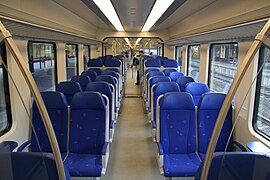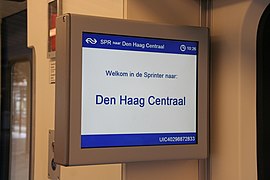NS series SLT
| Sprinter Lighttrain (SLT) | |
|---|---|
|
Sprinter Lighttrain in six-part design
|
|
| Numbering: | 2401-2469 2601-2662 |
| Number: | 4-part: 69 6-part: 62 |
| Manufacturer: | Bombardier , Siemens |
| Year of construction (s): | 2007 to 2010 |
| Axis formula : | 4-part: Bo '(2') (2 ') (Bo') Bo ' 6-part: Bo' (Bo ') (2') (2 ') (2') (Bo ') Bo' |
| Gauge : | 1435 mm ( standard gauge ) |
| Length over coupling: | 4-part: 69.36 m 6-part: 100.54 m |
| Empty mass: | 4-part: 129 t 6-part: 176 t |
| Service mass: | 4-part: 144 t 6-part: 192 t |
| Top speed: | 160 km / h |
| Traction power: | 4-part: 6 × 250 kW 6-part: 8 × 250 kW |
| Power system : | 1.5 kV direct current |
| Seats: | 4-part: 222 6-part: 332 |
| Standing room: | 4-part: 68 6-part: 108 |
The SLT or Sprinter Lighttrain is an electric local multiple unit from the Nederlandse Spoorwegen . It is used for sprinter missions .
General and area of application
The name Sprinter stands for use in S-Bahn-like traffic, as wide entrances enable fast passenger changes. The trains, which were developed based on the German class 425 , connect the metropolitan areas in the west of the Netherlands with each other in regional and local traffic. They will gradually replace older vehicles.
The regional trains were used for the trial operation on the route Den Haag - Utrecht and were given the train number series 9800. After problems, the trains were given the top name slet by staff and travelers - based on the English-language name .
The trains comply with the new Dutch railway law RKS ( Regeling keuring spoorvoertuigen ). This covers, among other things, a collision scenario of a collision at 110 kilometers per hour with a 15-ton obstacle.
Manufacturer and history
On July 21, 2005, the Dutch Railways commissioned a consortium of Bombardier Transportation and Siemens Transportation Systems to build a total of 35 trains. The order comprised 246 vehicles (wagons) with an option for up to 800 more. The delivery should take place between September 2008 and October 2009. The order value, including the option, was 1.2 billion euros. The order value for the first 35 trains was 248 million euros, 104 million euros of which went to Bombardier and 144 million euros to Siemens.
The trains replaced the T and V series multiple units built in the 1960s and 1970s. It was also planned to replace the nine SM90 prototype multiple units from the 1990s.
The six-part model was assembled at the Siemens plant in Krefeld - Uerdingen , the four-part model at the consortium leader Bombardier. All four-part units were commissioned in the Bombardier factory in Aachen , and the six-part units in the Siemens test center in Wegberg-Wildenrath . At the end of February 2009, the customer Nederlandse Spoorwegen accepted the first two trains from the consortium of Siemens and Bombardier.
Two options were redeemed by the Dutch Railways in September 2007. This comprised a further 32 four-car and 32 six-car electric multiple units with a total value of 399 million euros , with Bombardier's share being 162 and Siemens 237 million euros. Here, too, the four-part models were manufactured in the Bombardier production facilities in Aachen and Hennigsdorf, and the six-part models at Siemens in Krefeld-Uerdingen. In September 2009 the third option was redeemed for 19 four-car and 13 six-car train units. All 13 six-car and one four-car were manufactured by Siemens, the other 18 four-car by Bombardier. Further options that were initially planned were no longer redeemed.
A total of 658 of the 1046 previously planned cars were manufactured and delivered between 2008 and 2010. Ultimately, there were 69 four-car models (2400 series) and 62 six-car models (2600 series).
The railway company came under fire because all Sprinter trains are equipped without toilets. According to the Dutch Railways, this is not necessary on short journeys because the toilets are hardly used; The maintenance and cleaning mainly causes higher costs for the operator. However, early on after commissioning, Sprinter sets were also increasingly used on longer rail routes. This led to increasing protests, which were also carried to the political level. Other complaints from passengers concerned the seats, especially in 1st class: the only difference is the upholstery color (blue in 2nd class, red in 1st class) with a fare increase of around 40%.
There were further protests from the train crew, who had already pointed out problems before the first series was delivered. This included the entrance from the track area, the lack of a separate room for the train attendants and, above all, the glass rear wall to the driver's cab. The staff feared a lack of privacy, blinding light from the passenger compartment when driving in the dark and that passengers could unwittingly witness accidents. The management of the NS at the time dismissed these complaints or tried to deal with them with measures it considered inadequate.
The trains are to be equipped with toilets and ETCS between 2021 and 2025 .
photos
Individual evidence
- ↑ a b c d Articulated Sprinters to take over RANDSTAD stopping services . In: Railway Gazette International . tape 161 , no. 9 , 2005, ISSN 0373-5346 , p. 541 f .
- ↑ a b c d Harry Hondius: Civity and Flirt to boost NS fleet . In: Railway Gazette International . tape 171 , no. 4 , 2015, ISSN 0373-5346 , p. 54-55 .
- ^ Bombardier takes Dutch regional order . In: Railway Gazette International . tape 171 , no. 8 , 2005, ISSN 0373-5346 , p. 461 ( online ).
- ↑ Dutch railway plans "pee bags". Article on derstandard.at from October 7, 2011.






